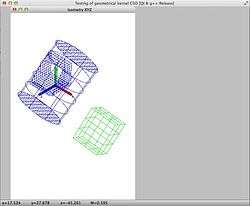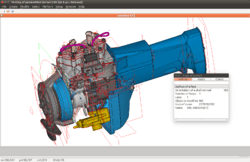C3D
  | |
| Developer(s) | C3D Labs, ASCON |
|---|---|
| Initial release | 1995 |
| Stable release |
V16
/ January 27, 2015[1] |
| Written in | C++, C Sharp |
| Operating system |
Windows, Mac X, Linux, Android |
| Platform |
Cross-platform, 32- and 64-bit |
| Available in |
2 languages: English, Russian |
| Type |
3D Modeler, 3D Solver, 3D Converter, CAD, CAM, CAE, API, Computer-aided software engineering tools |
| License | Proprietary software |
| Website |
www |
C3D is a geometric modeling kernel originally developed by ASCON Group, now by C3D Labs, using C++ and written in Visual Studio.[2] The C3D kernel used in software products as the component responsible for geometric model construction and constructed model control. It can be licensed by other companies for use in their 3D computer graphics software products. The most widely known software in which geometric kernels, like C3D, are typically used are computer aided design (CAD), computer-aided manufacturing (CAM), and computer-aided engineering (CAE) systems.[3]
As the software development tool, C3D incorporates four CAD modules: 3D modeling, 3D constraint solving, 3D visualization, and 3D file conversions:
- C3D Modeler constructs geometric models, generates flat projections of models, performs triangulations, calculates the
inertial characteristics of models, and determines whether collisions occur between the elements of models; - C3D Solver makes connections between the elements of geometric models, and considers the geometric constraints of models being edited;
- C3D Vision controls the quality of rendering for 3D models using mathematical apparatus and software, and the workstation hardware;
- C3D Converter reads and writes geometric models in a variety of standard exchange formats.[4]
History
Nikolai Golovanov is a graduate of the Mechanical Engineering department of Bauman Moscow State Technical University as a designer of space launch vehicles. Upon his graduation, he began with the Kolomna Engineering Design bureau, which at the time employed the future founders of ASCON, Alexander Golikov and Tatiana Yankina. While at the bureau, Mr Golovanov developed software for analyzing the strength and stability of shell structures.
In 1989, Alexander Golikov and TatianaYankina left Kolomna to start up ASCON as a private company. Although they began with just an electronic drawing board, even then they were already conceiving the idea of three-dimensional parametric modeling. This radical concept eventually changed flat drawings into three-dimensional models. The ASCON founders shared their ideas with Nikolai Golovanov, and in 1996 he moved to take up his current position with ASCON. Today he continues to develop algorithms in C3D.[5]
The most significant improvements of the C3D kernel made each year:[6]
2000: 3D solid modeling algorithms created.
2001: Geometric constraint manager implemented; data converter written to handle standard exchange formats.
2002: Associative views of 3D models added.
2003: Basic surface modeling features created.
2004: Sheet metal modeling algorithms.
2005: Manifold solid modeling implemented.
2007: Wireframe modeling added.
2008: Kinematic joints implemented for modeling mechanisms.
2009: Support for geometric model attributes added.
2010: Full-fledged surface modeling appears.
2011: Expansion to cross-platform support.
2012: Direct modeling elements implemented.
2013: English documentation localized; support for test applications added.
Functionality
C3D Modeler
- Modeling 3D solids
- Performing Boolean operations
- Creating thin-walled solids
- Filleting and chamfering parts
- Modeling sheetmetal parts
- Designing with direct modeling
- Modeling 3D surfaces
- Modeling 3D wireframe objects
- Surface triangulation
- Performing geometric calculations
- Casting planar projections
- Creating section views
- Calculating mass inertia properties
- Collision detection
C3D Converter
Boundary representation (B-Rep):
- STEP (protocols AP203, AP214)
- Parasolid X_T, X_B (read v.25.0/write v.10.0)
- ACIS SAT (read v.22.0/write v.2.0)
- IGES (read v.5.3/write v.5.3)
C3D Vision
- Configures levels of detail (LOD)
- Applies shaders and widgets
- Uses 3D assembly feature tree managers
- Controls static graphics and dynamic scenes
- Sets anti-aliasing levels
- Culls invisible elements of scenes
- Speeds up visual computing through hardware acceleration[7]
C3D Solver
- 2D constraint solver for 2D drawings and 3D sketches
- 3D constraint solver for assemblies and kinematic analyses
The C3D Solver supports the following constraint types:[8]
- Coincidence (available in 2D and 3D)
- Align points (2D)
- Angle (2D and 3D)
- Coaxiality (3D)
- Distance (2D and 3D)
- Equal lengths (2D)
- Equal radii (2D)
- Fix geometry (2D and 3D)
- Fix length and direction (2D)
- Incidence (2D)
- Parallelism (2D and 3D)
- Perpendicularity (2D and 3D)
- Radius (2D)
- Tangency (2D and 3D)
Features
The development environment operates using these programs:[9]
- MS Visual Studio 2013
- MS Visual Studio 2012
- MS Visual Studio 2010
- MS Visual Studio 2008
- MS Visual Studio 2005
- Clang (for Mac OS)
- GCC (for Linux)
- NDK (for Android)
The supported programming languages include:
Applications
Since 2013 - the date the company started issuing a license for the kernel-, several companies have adopted the kernel for their products, users include:
Recently, C3D has been adapted to Teigha.[12][13]
Education
Among the customers of C3D, there are educational institutions who are using the kernel for teaching students how to program with geometric kernels.[14]
- Tomsk Polytechnic University
- Voronezh State University
- Saint Petersburg State Institute of Technology
- Mordovian State University
- Shevchenko Transnistria State University
- Ulyanovsk State Technical University
See also
- Computer-aided design
- CAD standards
- Computer-aided manufacturing
- Computer-aided engineering
- Geometric modeling kernel
- Geometric modeling
- Solid modeling
External links
- Official website
- Official ASCON's C3D web page
- Official LEDAS's C3D web page
- Official Skolkovo's C3D web page
- Renga Architecture website
- The Geometric Modeling book by Dr. Golovanov[15]
References
- ↑ "C3D Labs Introduces V16 of C3D Geometric Kernel". LEDAS Ltd. January 29, 2015.
- ↑ Maher, Kathleen (June 6, 2013). "Does the CAD World Need Another Geometry Kernel?". Graphically Speaking. GraphicSpeak.
- ↑ Wong, Kenneth (May 14, 2014). "A New Geometric Kernel from Russia". Desktop Engineering. Peerless Media, LLC.
- ↑ Jeff, Rowe (April 3, 2014). "LEDAS Geometry Comparison Technology Embeds ASCON C3D Kernel". MCADCafe. Internet Business Systems, Inc.
- ↑ Grabowski, Ralph (December 4, 2012). "ASCON interviews Nikolai Golovanov, head of C3D kernel development". WorldCAD Access. upFront.eZine Publishing, Ltd.
- ↑ "History of C3D Labs". ASCON Co. 2015.
- ↑ Shura, Collinson (September 1, 2016). "C3D Labs Launches New Visualizer For Engineering Software Developers". Skolkovo Foundation.
- ↑ Nikolay Golovanov (2014). Geometric Modeling: The mathematics of shapes. CreateSpace Independent Publishing Platform. ISBN 978-1497473195.
- ↑ "Geometric Kernel for 2D and 3D Software Developers" (PDF). C3D Labs, LLC. 2015.
- ↑ "nanoCAD Plus will be developed on the C3D kernel from ASCON". C3DLab. 2016.
- ↑ "Russia's Leader in Nuclear Power Licenses C3D Kernel". ASCON. 2015.
- ↑ Grabowski, Ralph (September 7, 2015). "C3D kernel for Teigha". WorldCAD Access. upFront.eZine Publishing, Ltd.
- ↑ "The Present and Future of DWG". ENGINEERING. 2015.
- ↑ "Customers of C3D Labs".
- ↑ "Geometric Modeling by Nikolay Golovanov" (PDF). C3D Labs. 2015.